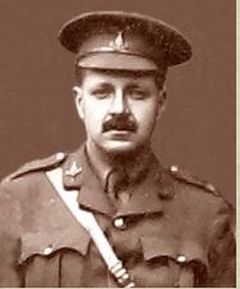
Erasmus Darwin was born on the 7th December 1881 in Cambridge and lived at ‘The Orchard’. He was the only son of Horace Darwin FRS (Fellow of the Royal Society) who was Chairman of the Cambridge Scientific Society. He was also the grandson of the famous naturalist Charles Darwin.
Erasmus was educated at Horris Hill School near Newbury and at Marlborough. He then went on to Trinity College, Cambridge University to study Mathematics. On leaving Cambridge he worked at Mather and Platts in Manchester, a hydraulics and pump engineering company. He then moved on to work for Bolckow, Vaughn & Co Ltd Iron and Steel in Middlesbrough, whereby, at the outbreak of the war he was Secretary of the Company. He lived at the time at Saltburn on the north east Yorkshire coast.
As soon as war broke out he joined up and was gazetted on the 12th September 1914 as a 2nd Lieutenant the 4th Battalion Yorkshire Regiment. Apparently just before he left England he was summoned to the War Office and offered a Staff appointment at home in connection to munitions work. Though the work was important he opted to stay with his unit making the case that there were plenty of older men equally qualified for the work.
The 4th Battalion arrived in France on the 18th April 1915 and were straight away into the 2nd Ypres offensive which started on the 22nd April. The Battalion was involved in the Battle of St Julien in the heart of the Ypres Salient. During an attack at a location called Fortuin on the 24th Erasmus was killed. His commanding office, Colonel Bell, said of him: ‘Loyalty, courage and devotion to duty, he had them all. He died in an attack that gained many compliments to the Battalion. He was right at the front. It was a man’s death’.
Erasmus has no known grave and is commemorated on the Menin Gate. He was 33 years of age.
Explore more memories from the ribbon
-
John Lionel Calvert Booth
John Lionel Calvert Booth – research by John Broom Born in Catterick Village in 1876, he worked as a farmer and then became a 2nd Lieutenant in the Yorkshire Regiment 1897. He was the son of John Bainbridge and Margaret Alice who in 1881 were living at Killerby Hall, Killerby, Yorkshire. He had served 15 years as captain with the Yorkshire Regiment.He also appears to have been the editor of a book called ‘Sporting Rhymes and Pictures’ in 1898. Booth married in 1905. His two sons were born in 1906 and 1909. During the Boer and the Balkan Wars between Bulgaria and Turkey (1904 and 1909) he served as a war correspondent and artist, representing ‘The Graphic’ in the latter. In 1909 he was severely wounded at Constantinople. He also contributed to ‘Punch’, the satirical magazine and was author and illustrator of ‘Trouble in the Balkans’. In 1912 he began farming in Australia and later became a Boy Scout troop leader. At the time of his enlistment into the AIF he lived with his wife Margaret Caroline at The Cottage, Serpentine Road, Albany, New South Wales. He embarked from Freemantle on H.M.A.T. A7 Medic on the 2nd November 1914 for the Mediterranean. He was wounded in action near the Dardanelles on the 25th April 1915. On 1st May he died of his wounds while bound for Malta on Hospital Ship “Mashroba” and was buried at sea. He was Mentioned in Despatches.
-
John Smith
Jane Metcalfe visited the museum and outlined the story of her father, John Smith. He was born in Dundee, Forfar in 1883. After working as a boilermaker, he joined the Royal Engineers on 1 September 1909 and remained in military service until 31 January 1930. He spent time at Catterick Camp one hundred years ago at the time of the garrison’s founding. During the First World War John served in Egypt, before being transferred to the British Expeditionary Force in France. He became a Lance Corporal, and was promoted to Sergeant in April 1917. His record was ‘Exemplary’, and he was described as ‘Extremely honest, sober and reliable. A good organiser and very good in charge of men.’ 1852361 Sergeant John smith was awarded the 1914 Star, the British War medal, the Victory medal, the General Service medal and the Long Service and Good Conduct medal.
-
Lt Henry Stanley Tempest Bullen
Jennifer Bullen visited the museum to show us the memorial plaque to Lt Henry Stanley Tempest Bullen, her father-in-laws elder brother. Harry Bullen of ‘D’ Battery, 251st Brigade of the Royal Field Arilltery was Killed in Action on 14th April 1917 during the Battle of Arras (an action launched in support and as a diversionary action to the larger French offensive on the Chemin des Dames). He died at the age of 20 and is buried south of Arras at Beaurains Road Cemetery, which was designed by Sir Edwin Lutyens. His mother, Edith Bullen lived in Gosforth, Northumberland. A memorial window to Lt Bullen was erected in St Nicholas Church, Gosforth following the war.
